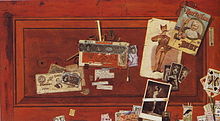John Haberle
John Haberle (* 1856 in New Haven , Connecticut ; † February 3, 1933 ibid) was an American painter of the 19th century who specialized primarily in trompe-l'œils .
Life
Haberle's parents immigrated to the United States from Switzerland . At the age of 14 he gave up school to learn the profession of engraver . In his occupation he was a long-time employee of the paleontologist Othniel Charles Marsh . One year in 1884 he was enrolled as a student at the National Academy of Design . Haberle became known as an artist for his depictions of paper money . Although he from the Secret Service , the Secret Service had been the United States, warned so, he continued to paint remarkably genuine banknotes in his pictures.
plant
The Haberle style is known for the fact that it neither structured as precisely as William Michael Harnett nor as colorfully as John Frederick Peto , who, alongside him, are considered to be the main exponents of this style in the late 19th century. Haberle is known for his technically very well implemented compositions and for the humorous elements in his pictures. Less than 40 works have survived from him today. In 1949 the work of the long-forgotten painter was rediscovered.
literature
- Thomas W. Gaethgens: Pictures from the New World. American painting of the 18th and 19th centuries, Prestel-Verlag, Munich 1988. ISBN 3-7913-0879-3 .
Web links
Image selection
Individual evidence
- ^ William Hauptman, Corinne Currat, Dominique Hoeltschi: Peindre l'Amérique - Les artistes du Nouveau Monde 1830-1900 . In: La Bibliothèque des Arts . 1st edition. Fondation de l'Hermitage , Lausanne 2014, ISBN 978-2-88453-186-3 , p. 166 .
| personal data | |
|---|---|
| SURNAME | Haberle, John |
| BRIEF DESCRIPTION | American painter |
| DATE OF BIRTH | 1856 |
| PLACE OF BIRTH | New Haven , Connecticut, USA |
| DATE OF DEATH | February 3, 1933 |
| Place of death | New Haven , Connecticut, USA |





